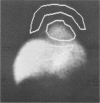Abstract
To provide an objective rapid means of excluding extrahepatic biliary atresia (atresia), a hepatic index was devised from the ratio of the net hepatic to cardiac distribution of 99mTc diisopropyl iminodiacetic acid or methylbrom iminodiacetic acid between 2.5 and 10 minutes after injection. The hepatic index was compared with subjective assessment of abdominal scintigraphy performed repeatedly over 24 hours. In 22 infants with hepatitis the hepatic index ranged from 5.03 to 14.9, one having no excretion on scintiscan. In 26 infants with atresia the index ranged from 0.49 to 4.26 and in two with paucity of intralobular bile ducts it was 1.85 and 3.69. None of these infants had excretion apparent on scintiscans. Similarly, low hepatic indices occurred in four infants with liver dysfunction but pigmented stools, three of whom had no excretion apparent on scintiscans. These preliminary studies suggest that a hepatic index of greater than 5 is much more rapid and as specific in excluding atresia as repeated abdominal scintigraphy.
Full text
PDF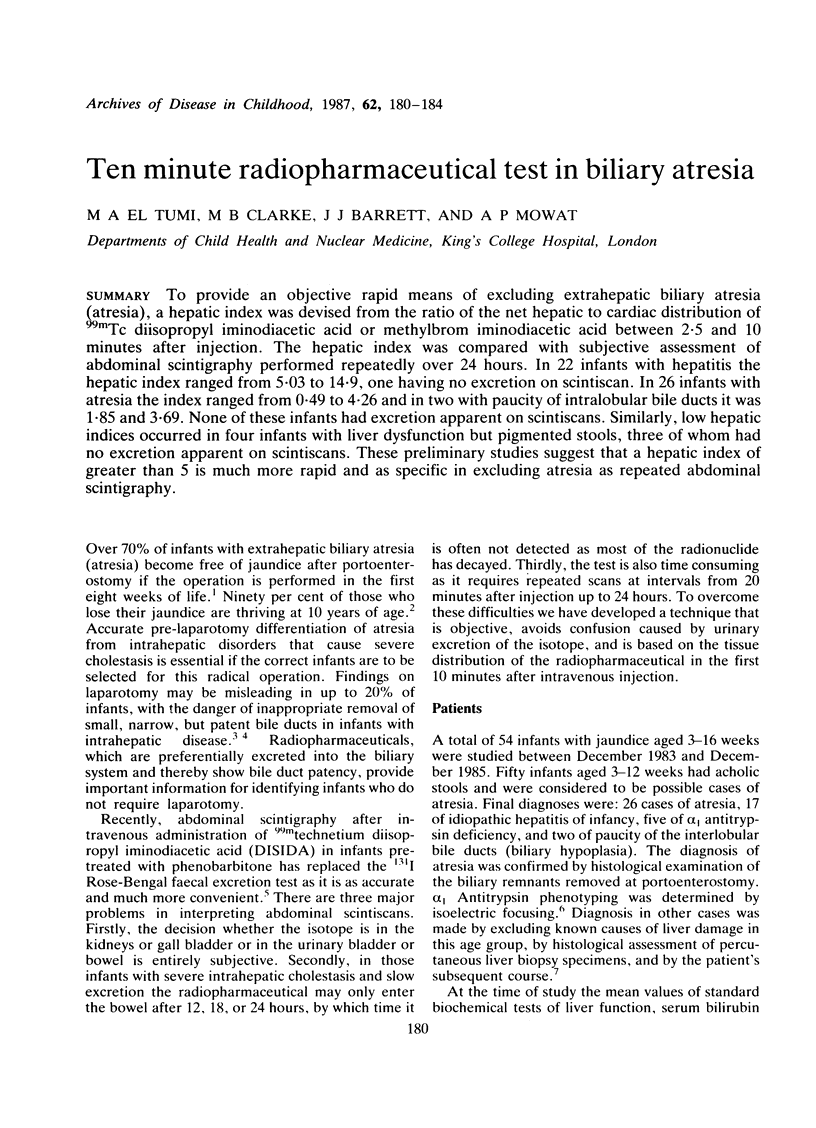
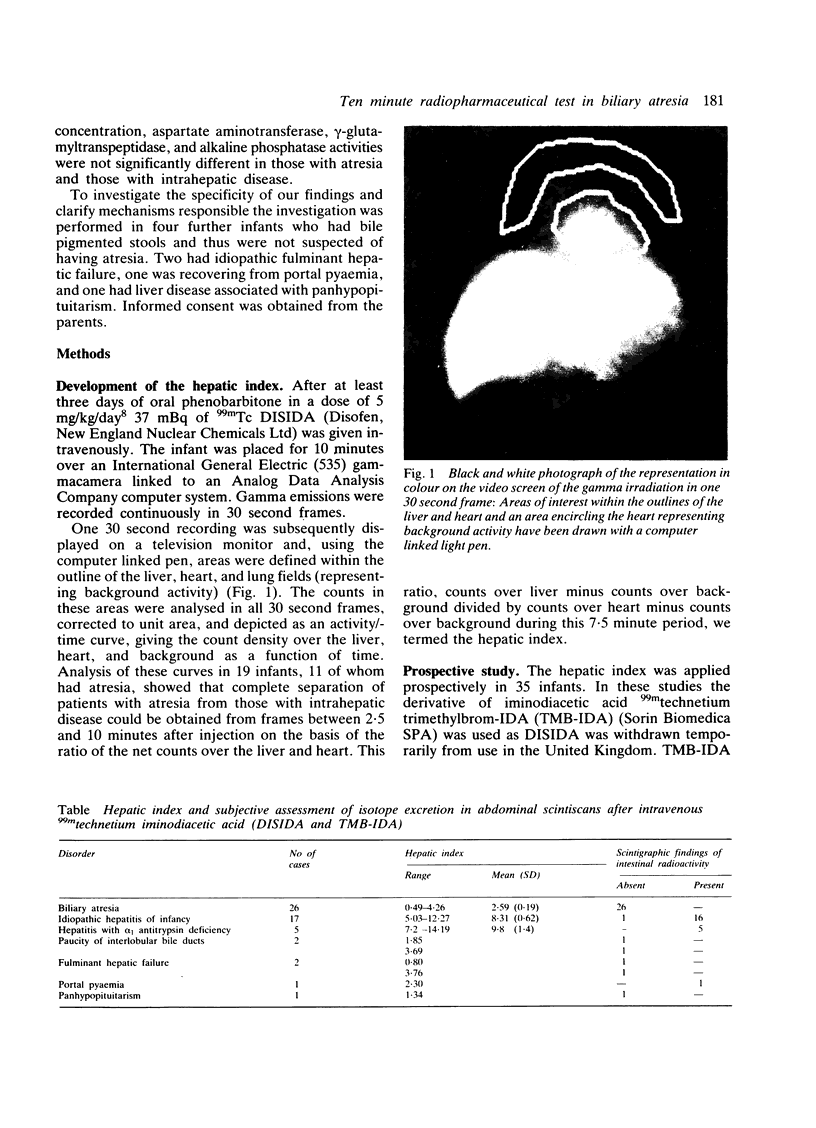
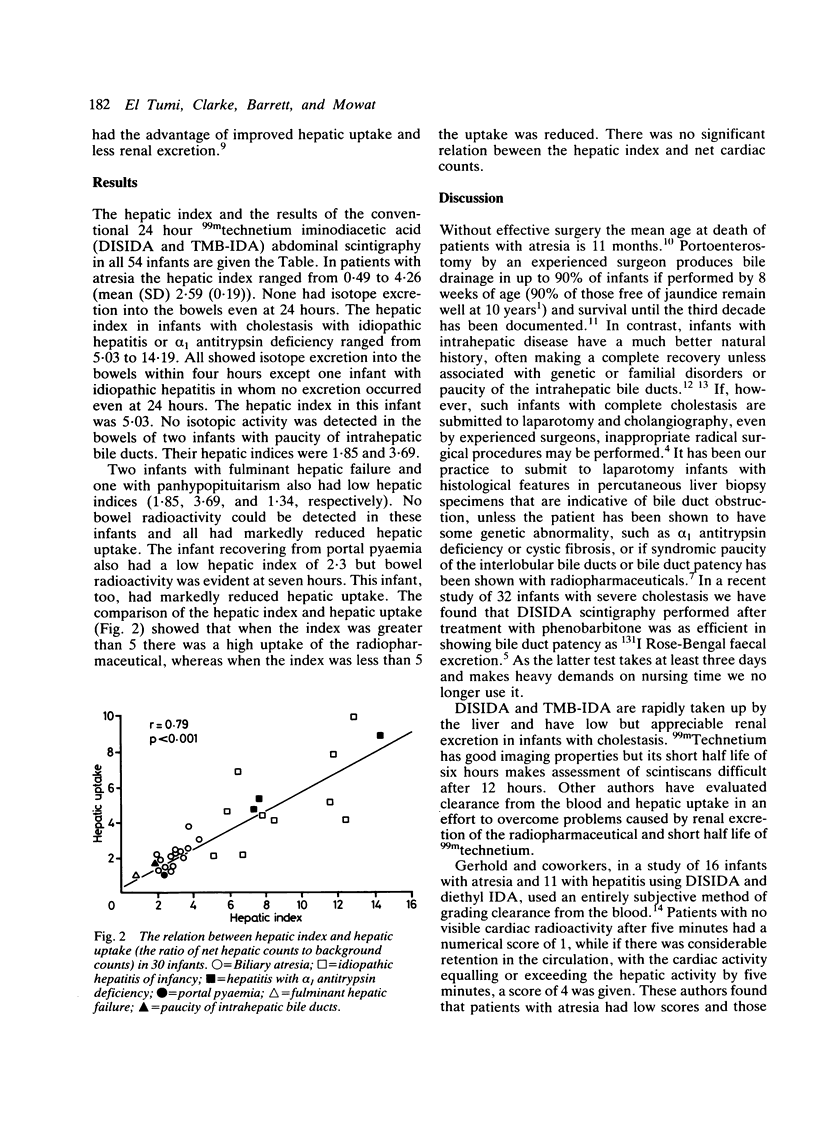
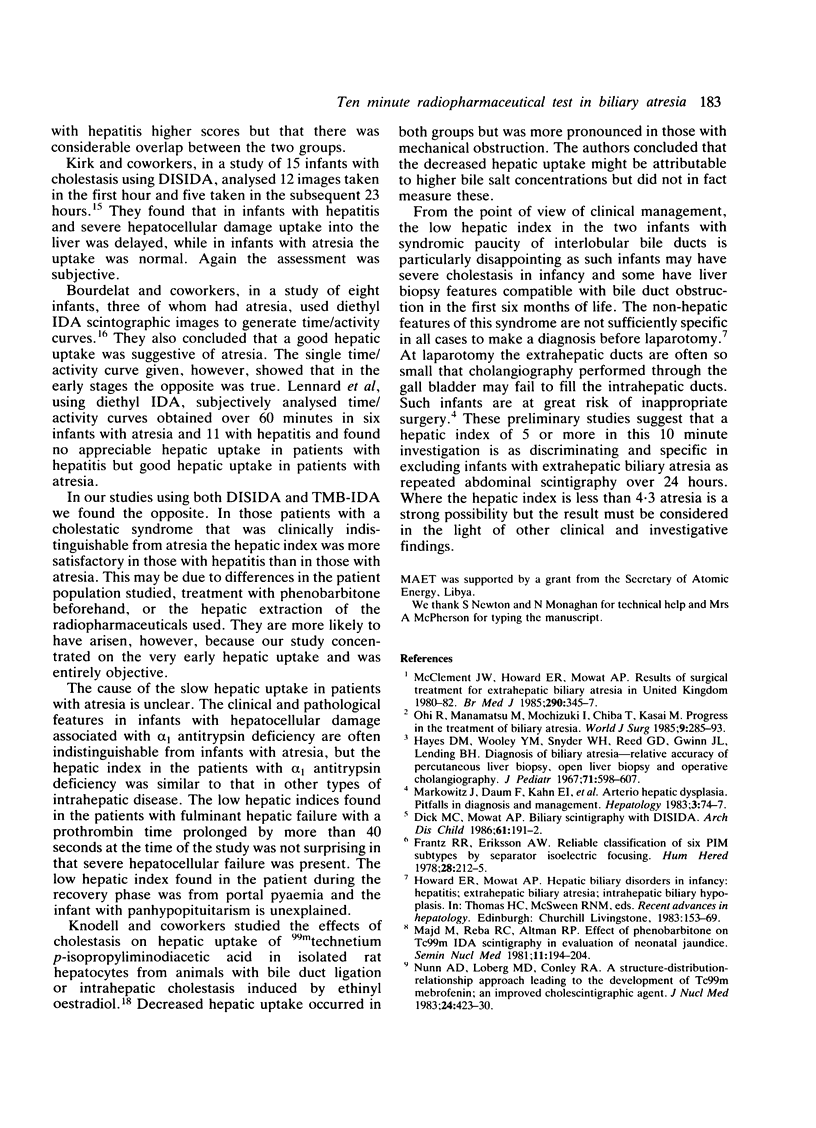
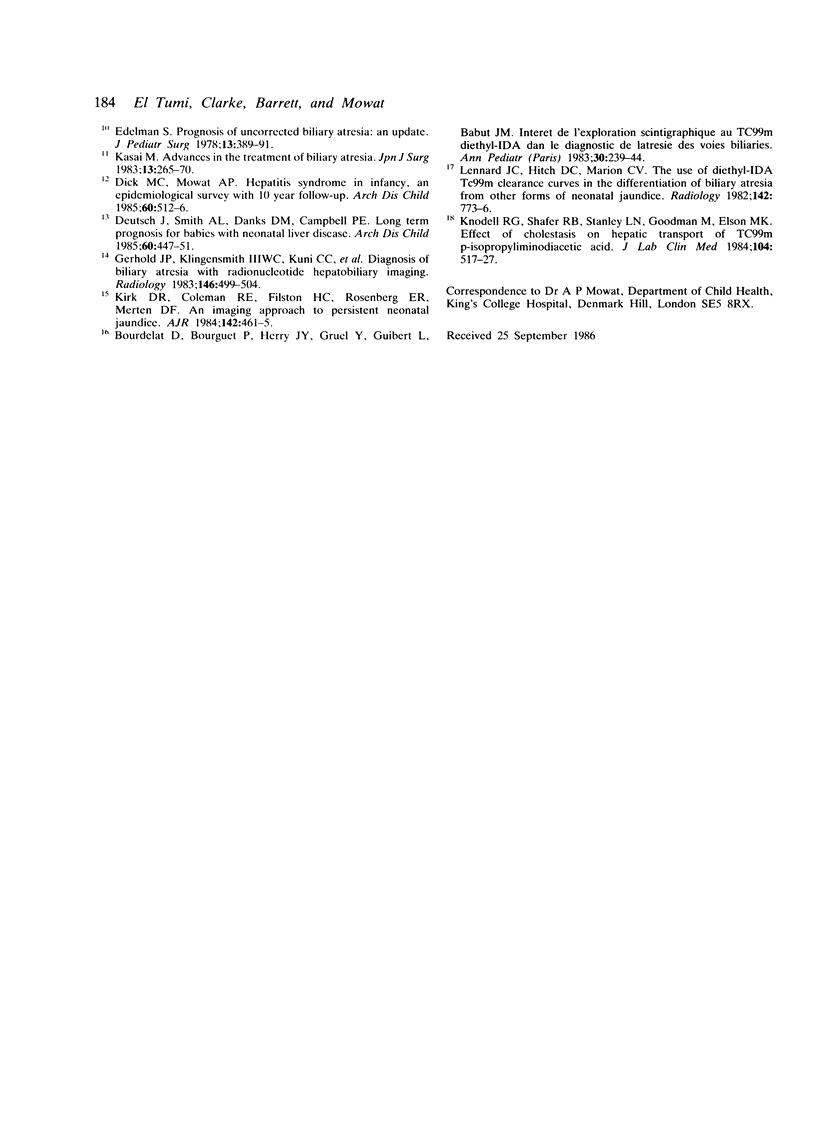
Images in this article
Selected References
These references are in PubMed. This may not be the complete list of references from this article.
- Adelman S. Prognosis of uncorrected biliary atresia: an update. J Pediatr Surg. 1978 Aug;13(4):389–391. doi: 10.1016/s0022-3468(78)80462-x. [DOI] [PubMed] [Google Scholar]
- Bourdelat D., Bourguet P., Herry J. Y., Gruel Y., Guibert L., Babut J. M. Intérêt de l'exploration scintigraphique au 99mTc-diéthyl-IDA dans le diagnostic de l'atrésie des voies biliaires. Ann Pediatr (Paris) 1983 Apr;30(4):239–244. [PubMed] [Google Scholar]
- Deutsch J., Smith A. L., Danks D. M., Campbell P. E. Long term prognosis for babies with neonatal liver disease. Arch Dis Child. 1985 May;60(5):447–451. doi: 10.1136/adc.60.5.447. [DOI] [PMC free article] [PubMed] [Google Scholar]
- Dick M. C., Mowat A. P. Biliary scintigraphy with DISIDA. A simpler way of showing bile duct patency in suspected biliary atresia. Arch Dis Child. 1986 Feb;61(2):191–192. doi: 10.1136/adc.61.2.191. [DOI] [PMC free article] [PubMed] [Google Scholar]
- Dick M. C., Mowat A. P. Hepatitis syndrome in infancy--an epidemiological survey with 10 year follow up. Arch Dis Child. 1985 Jun;60(6):512–516. doi: 10.1136/adc.60.6.512. [DOI] [PMC free article] [PubMed] [Google Scholar]
- Gerhold J. P., Klingensmith W. C., 3rd, Kuni C. C., Lilly J. R., Silverman A., Fritzberg A. R., Nixt T. L. Diagnosis of biliary atresia with radionuclide hepatobiliary imaging. Radiology. 1983 Feb;146(2):499–504. doi: 10.1148/radiology.146.2.6681570. [DOI] [PubMed] [Google Scholar]
- Hays D. M., Woolley M. M., Snyder W. H., Jr, Reed GB GWINN J. L., Landing B. H. Diagnosis of biliary atresia: relative accuracy of percutaneous liver biopsy, open liver biopsy, and operative cholangiography. J Pediatr. 1967 Oct;71(4):598–607. doi: 10.1016/s0022-3476(67)80118-5. [DOI] [PubMed] [Google Scholar]
- Kasai M. Advances in treatment of biliary atresia. Jpn J Surg. 1983 Jul;13(4):265–276. doi: 10.1007/BF02469507. [DOI] [PubMed] [Google Scholar]
- Kirks D. R., Coleman R. E., Filston H. C., Rosenberg E. R., Merten D. F. An imaging approach to persistent neonatal jaundice. AJR Am J Roentgenol. 1984 Mar;142(3):461–465. doi: 10.2214/ajr.142.3.461. [DOI] [PubMed] [Google Scholar]
- Knodell R. G., Shafer R. B., Stanley L. N., Goodman M., Elson M. K. Effect of cholestasis on hepatic transport of 99mtechnetium p-isopropyl-iminodiacetic acid. J Lab Clin Med. 1984 Oct;104(4):517–527. [PubMed] [Google Scholar]
- Leonard J. C., Hitch D. C., Manion C. V. The use of diethyl-IDA Tc 99m clearance curves in the differentiation of biliary atresia from other forms of neonatal jaundice. Radiology. 1982 Mar;142(3):773–776. doi: 10.1148/radiology.142.3.7063701. [DOI] [PubMed] [Google Scholar]
- Majd M., Reba R. C., Altman R. P. Effect of phenobarbital on 99mTc-IDA scintigraphy in the evaluation of neonatal jaundice. Semin Nucl Med. 1981 Jul;11(3):194–204. doi: 10.1016/s0001-2998(81)80004-9. [DOI] [PubMed] [Google Scholar]
- Markowitz J., Daum F., Kahn E. I., Schneider K. M., So H. B., Altman R. P., Aiges H. W., Alperstein G., Silverberg M. Arteriohepatic dysplasia. I. Pitfalls in diagnosis and management. Hepatology. 1983 Jan-Feb;3(1):74–76. doi: 10.1002/hep.1840030112. [DOI] [PubMed] [Google Scholar]
- McClement J. W., Howard E. R., Mowat A. P. Results of surgical treatment for extrahepatic biliary atresia in United Kingdom 1980-2. Survey conducted on behalf of the British Paediatric Association Gastroenterology Group and the British Association of Paediatric Surgeons. Br Med J (Clin Res Ed) 1985 Feb 2;290(6465):345–347. doi: 10.1136/bmj.290.6465.345. [DOI] [PMC free article] [PubMed] [Google Scholar]
- Nunn A. D., Loberg M. D., Conley R. A. A structure-distribution-relationship approach leading to the development of Tc-99m mebrofenin: an improved cholescintigraphic agent. J Nucl Med. 1983 May;24(5):423–430. [PubMed] [Google Scholar]
- Ohi R., Hanamatsu M., Mochizuki I., Chiba T., Kasai M. Progress in the treatment of biliary atresia. World J Surg. 1985 Apr;9(2):285–293. doi: 10.1007/BF01656322. [DOI] [PubMed] [Google Scholar]



